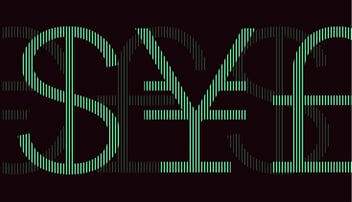Gain an overview of the latest developments on the currency market and anticipate fluctuation risks.
EUR/USD
High: 1.1454 / Low: 1.0825 / Change: -1.5%
The EUR/USD pair was – naturally – highly volatile throughout March due to uncertainty around the COVID-19 crisis. On both sides of the Atlantic, central banks acted speedily. The ECB focused on asset purchases (or quantitative easing, QE) as a means of supporting economic activity. In total, some 1,050 billion euros will be injected into the financial markets by the end of the year. Meanwhile the US Federal Reserve cut its policy rate, the federal funds rate, to a target range of 0 to 0.25% and announced unlimited QE (comprising purchases of both government bonds and corporate bonds). Given the sweeping measures taken by both central banks, further announcements are unlikely to be made in the coming weeks.
EUR/GBP
High: 0.9435 / Low: 0.8675 / Change: +1.4%
The euro gained nearly 1.4% against sterling in March. The fall in the UK currency cannot be explained solely by the coronavirus crisis – there are structural reasons for it. We identify three factors behind the fall: the very high balance of payments current account deficit (the highest as a proportion of GDP of the G10 countries), high exposure to a banking sector that has been weakened by the current crisis, and the lower appeal of sterling (GBP) as an international reserve currency, due to Brexit-related uncertainty. While these structural factors persist, the UK currency will probably continue to fall on the exchange markets.
EUR/JPY
High: 121.03 / Low: 118.13 / Change: -1.7%
In March, the EUR/JPY pair remained within a range of 118 to 121. Unsurprisingly given the international situation, the yen has served as a safe-haven currency. Close attention will have to be paid in the coming weeks because if the yen continues to rise, the authorities might be forced to intervene in the exchange markets. Tokyo has already hinted at this scenario in recent weeks.
EUR/CHF
High: 1.0708 / Low: 1.0556 / Change: -0.8%
The EUR/CHF pair lost just 0.8% in March. The Swiss National Bank (SNB) stepped up its exchange market interventions, in the form of euro purchases, to limit the rise of the Swiss franc. Based on the changing level of overnight deposits with the central bank, the volume of interventions is at its highest since 2014. Remember that a few months later, the SNB was forced to scrap its EUR/CHF floor rate of 1.20 under severe market pressure. For the time being, the unofficial minimum exchange rate of 1.05 seems to be holding but the buying pressure on the CHF will very likely grow as the economic picture worsens in the coming months.
EUR/CAD
High: 1.5875 / Low: 1.4918 / Change: +5.4%
The euro put up one of its best monthly performances against the Canadian dollar. The Canadian currency was dragged down by a combination of factors: the collapse in the oil barrel price, which analysts reckon could hit 10 dollars, and the Bank of Canada’s expansionary measures. The central bank cut its key policy rate from 1.75% to 0.25% in March and announced a quantitative easing (QE) programme worth at least 5 billion Canadian dollars per week until the end of the economic crisis. This makes the Bank of Canada the sixteenth central bank to begin a similar programme this year.
Topics






